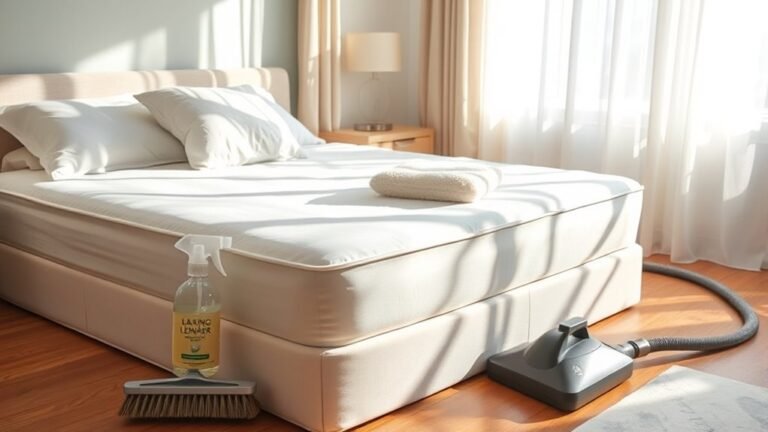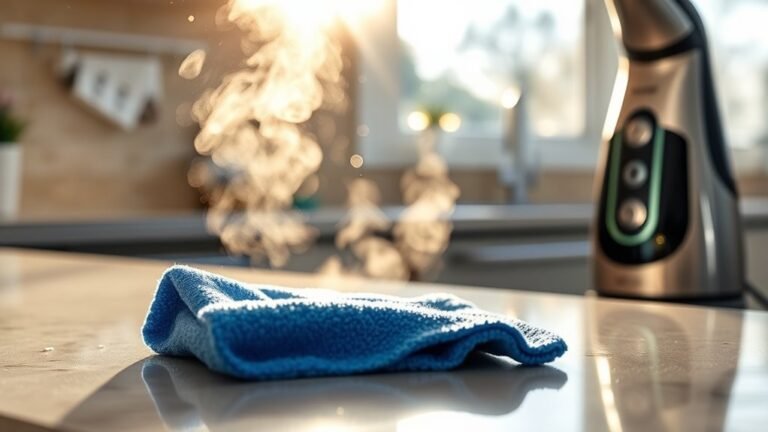DIY Cleaner for Chair
You can easily make a safe, effective DIY cleaner for your chairs using natural ingredients like vinegar, baking soda, and mild soap. For fabric, mix gentle detergent with water, and test on a hidden spot first. For leather, combine castile soap, distilled water, and a bit of white vinegar, then add natural oil to keep it soft. These homemade solutions refresh your furniture without harsh chemicals. Keep going, and you’ll find simple steps and tips to maintain your chairs perfectly.
Essential Ingredients for Homemade Chair Cleaners

When making a homemade cleaner for your chair, you’ll want to focus on a few key ingredients that are both effective and safe. Using natural ingredients like vinegar, baking soda, and lemon juice gives you powerful cleaning benefits without harsh chemicals. These components break down dirt and grime while being gentle on your chair’s material. Plus, they’re eco-friendly, letting you maintain your furniture without compromising your values or health. You’ll appreciate how these simple ingredients work together to freshen up your chair, removing odors and stains naturally. Embracing these natural options means you’re choosing freedom from synthetic chemicals and complicated products, empowering you to clean with confidence and responsibility every time.
Cleaning Solutions for Fabric Chairs
Natural ingredients like vinegar and baking soda provide a great foundation, but fabric chairs often need tailored solutions to tackle stains and odors effectively. You can mix a gentle detergent with water to create a cleaning spray that lifts dirt without harming fibers. For stubborn spots, a paste of baking soda and water works wonders, then vacuum it off once dry. Always test any solution on a hidden area first to guarantee fabric protection. Regular upholstery maintenance, like vacuuming and prompt stain treatment, keeps your chair looking fresh and extends its life. By customizing your cleaning approach, you gain freedom from harsh chemicals while preserving the comfort and style of your fabric chair. This way, your DIY cleaner truly supports both cleanliness and fabric care.
How to Make a Leather Chair Cleaner

You’ll need just a few essential ingredients to make an effective leather chair cleaner at home. I’ll guide you through a simple step-by-step process to keep your leather looking fresh and clean. Plus, I’ll share some tips to help you care for your leather and extend its life.
Essential Ingredients Needed
Creating an effective leather chair cleaner starts with choosing the right ingredients that are gentle yet powerful enough to remove dirt and grime without damaging the material. You’ll want a mild liquid soap, like castile soap, because it cleans deeply without stripping leather’s natural oils. Mixing in distilled water guarantees purity, avoiding mineral buildup that could harm your chair. Adding a small amount of white vinegar helps break down stubborn stains while balancing pH levels. A few drops of natural oil, such as almond or jojoba, restore moisture, keeping leather supple between cleaning frequencies. These ingredient benefits combine to create a cleaner that respects your chair’s integrity and your freedom to maintain it yourself, without harsh chemicals or expensive products.
Step-by-Step Cleaning Process
To make your leather chair cleaner, start by combining one cup of distilled water with a quarter cup of mild liquid soap in a spray bottle. Shake gently to mix. Now, follow these cleaning techniques to maintain your upholstery’s freedom and freshness without harsh chemicals.
| Step | Action |
|---|---|
| 1 | Spray solution lightly on leather |
| 2 | Wipe gently with a soft cloth |
| 3 | Focus on stained or dirty areas |
| 4 | Let air dry naturally, no heat needed |
This easy process supports upholstery maintenance while preserving the chair’s natural feel. Stick to gentle motions to avoid damage and enjoy a clean, free-spirited space.
Tips for Leather Care
Although leather is durable, it needs proper care to stay soft and crack-free. You want your leather chair to last and maintain its natural beauty, so regular leather conditioning is key. Use a gentle, homemade leather cleaner first, then apply a conditioner to keep the material supple and prevent drying out. Don’t forget protection techniques like keeping it away from direct sunlight and heat sources, which can cause fading and brittleness. Also, avoid harsh chemicals that strip natural oils. By combining these simple steps, you’re not just cleaning your chair—you’re preserving its freedom to flex and age gracefully. With consistent care, your leather chair remains comfortable and stylish, giving you the freedom to enjoy it for years without worry.
Natural Wood Chair Cleaning Recipes

When it comes to keeping your wooden chairs clean and vibrant, a few simple natural recipes can make all the difference. You can whip up an effective wood polish by mixing equal parts olive oil and white vinegar—this combo nourishes the wood while cutting through grime. Just apply it with a soft cloth, rub gently, and buff to a shine. For regular chair maintenance, a solution of mild dish soap and warm water works wonders to remove dust and light dirt without stripping the finish. Avoid harsh chemicals; natural ingredients keep your freedom intact by protecting your wood’s integrity. With these easy recipes, you’ll maintain your wooden chairs’ beauty and durability, all while enjoying the satisfaction of DIY care.
Tips for Removing Stains From Upholstered Chairs
Wood chairs often get the spotlight, but upholstered chairs need care too, especially when stains appear. You’ll want to identify stain types—like food, ink, or grease—before choosing cleaning techniques. For water-based stains, blot gently with a damp cloth, avoiding rubbing that pushes stains deeper. Oil-based stains call for a mild detergent mixed with water or a specialized upholstery cleaner. Always test your cleaner on a hidden spot first to keep your freedom intact from damage. For stubborn stains, a soft-bristled brush can help lift residue without harming fabric. Remember, quick action is your best ally. The sooner you address a stain, the easier it is to remove, letting you enjoy your upholstered chairs without worry or limits.
Deodorizing Chairs With DIY Sprays
If your chair needs a fresh scent, natural odor eliminators like baking soda or essential oils can do the trick. You’ll want to mix these into a spray for easy application. Just remember to test a small area first and apply lightly to avoid soaking the fabric.
Natural Odor Eliminators
Though odors can cling stubbornly to your chair, you don’t need harsh chemicals to freshen it up. By choosing natural ingredients, you tap into the power of odor absorption without compromising your health or the environment. Simple items like baking soda, white vinegar, and essential oils work wonders. Baking soda naturally absorbs odors, while vinegar neutralizes them, making your chair smell clean and fresh. Adding a few drops of essential oils not only enhances the scent but also offers antibacterial benefits. You’re free to customize your DIY spray, avoiding synthetic fragrances or chemicals that limit your choices. Embracing these natural odor eliminators lets you maintain a fresh, inviting chair in a way that aligns with your values and desire for simplicity.
Spray Application Tips
Applying your DIY deodorizing spray correctly can make all the difference in freshening up your chair effectively. Start by choosing the right nozzle type—fine mist nozzles cover a wider area gently, perfect for fabric chairs, while adjustable nozzles let you control spray patterns for targeted application. Avoid saturating the fabric; instead, use sweeping motions to evenly distribute the spray. This prevents over-wetting and guarantees quicker drying times. Test your spray pattern on a hidden spot first to avoid spots or damage. Remember, consistent, light layers work better than heavy, uneven sprays. By mastering these spray application tips, you’ll keep your chair smelling fresh without compromising the fabric’s integrity, giving you the freedom to enjoy a clean, inviting space every day.
Tools Needed for Effective Chair Cleaning
Before you plunge into cleaning your chair, it’s important to gather the right tools to make the process smooth and effective. You’ll want basic cleaning tools like a soft brush, microfiber cloths, and a spray bottle for your DIY cleaner. These help you tackle dirt without damaging the fabric or finish. Don’t forget maintenance supplies such as gentle detergents, upholstery cleaner, and a vacuum with an upholstery attachment. These essentials give you the freedom to clean thoroughly and keep your chair looking fresh. Having the right gear on hand means you won’t have to stop mid-cleaning to hunt for something. With these cleaning tools and maintenance supplies ready, you’re set to refresh your chair efficiently and with confidence.
Step-by-Step Guide to Cleaning Your Chairs at Home
With your cleaning tools and supplies ready, you can move on to the actual process of revitalizing your chairs. Start by removing any loose dirt or debris with a vacuum or soft brush to prevent damage during cleaning. Next, test your DIY cleaner on a hidden spot to verify it won’t harm the fabric. Apply the cleaner gently using a microfiber cloth, focusing on stains or dirty areas. Let it sit briefly, then blot with a damp cloth to lift grime without soaking the upholstery. For chair maintenance, repeat this routine monthly to keep chairs fresh and extend their life. Finally, apply upholstery protection to shield fabrics from spills and wear. This simple step-by-step approach gives you freedom to maintain your chairs beautifully at home.
Eco-Friendly Alternatives to Commercial Cleaners
Since you want to keep your cleaning routine safe for both your home and the planet, eco-friendly alternatives to commercial cleaners are a smart choice. You don’t have to rely on harsh chemicals when green cleaning offers effective, natural solutions. Simple ingredients like vinegar, baking soda, and lemon juice can tackle dirt and stains without compromising your health or the environment. Embracing these alternatives aligns perfectly with sustainable living, giving you freedom from toxic substances and reducing waste. Plus, making your own cleaner means you control what goes into it, ensuring safety for your family and pets. By choosing eco-friendly options, you’re not just cleaning your chair—you’re supporting a cleaner, greener lifestyle that respects the earth’s resources.
Preventative Care to Keep Chairs Looking New
Though regular cleaning is essential, taking preventative steps can keep your chairs looking new much longer. You can embrace simple chair maintenance habits that save time and effort down the road. Start by applying fabric protection sprays designed to repel stains and spills—this creates a barrier that keeps dirt from settling deep. Avoid placing chairs in direct sunlight to prevent fading, and rotate cushions regularly to guarantee even wear. Address spills immediately by blotting instead of rubbing to protect the fabric fibers. Using removable covers or throws can also shield your chairs from everyday messes without restricting your freedom to style your space. By committing to these straightforward steps, you’ll extend your chair’s lifespan and keep them fresh without constant deep cleaning.
Frequently Asked Questions
Can DIY Cleaners Damage Chair Upholstery Over Time?
You might wonder if homemade solutions can harm your chair upholstery over time. The effects of acidity in some DIY cleaners can weaken or discolor fabrics, especially if they’re not compatible with the material. You’ve got to know your fabric compatibility well—natural fibers react differently than synthetics. To keep your freedom in cleaning without damage, always test a small hidden spot first and avoid harsh acidic ingredients that could cause lasting harm.
How Often Should I Clean My Chairs With Homemade Solutions?
Think of your chairs as silent storytellers, bearing the marks of your daily life. To keep their tales bright, you should embrace a cleaning frequency of every 1-3 months, depending on use and exposure. Regular upholstery maintenance frees you from stubborn stains and lingering odors, letting your space breathe. By tuning into your chairs’ needs, you maintain their comfort and charm, giving you the freedom to relax without worry.
Are DIY Chair Cleaners Safe for Pets and Children?
You can definitely keep your space safe by choosing pet friendly ingredients and child safe cleaning solutions. Many natural DIY cleaners use things like vinegar, baking soda, or mild soap, which are generally gentle and non-toxic. Just be sure to avoid harsh chemicals or strong fragrances that might irritate little ones or pets. With the right ingredients, you’re free to clean confidently without worrying about harmful effects around your family.
Can I Store Homemade Chair Cleaner for Later Use?
Imagine you mixed a vinegar-based cleaner last weekend and want to use it again. You can store homemade cleaner for later use, but keep in mind storage tips to maintain cleaner longevity. Store it in a sealed, labeled container away from sunlight and heat to keep it effective for up to a month. This way, you’re free to clean whenever you want without constantly mixing new batches.
What Is the Best Way to Test a Cleaner on Delicate Fabrics?
You’ll want to perform a fabric sensitivity test before using any cleaner. Start by applying a small amount of the cleaner in an inconspicuous area—this is your cleaner patch test. Wait a few minutes to see if there’s any discoloration, damage, or texture change. This simple step gives you the freedom to clean confidently without risking harm to your delicate fabric, ensuring your chair stays looking great without surprises.






